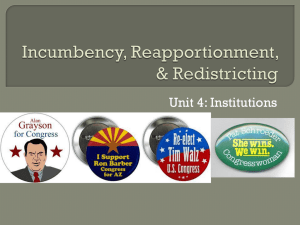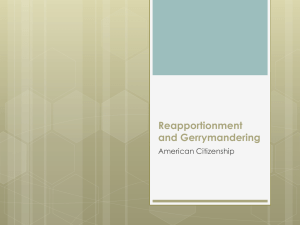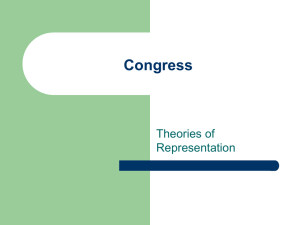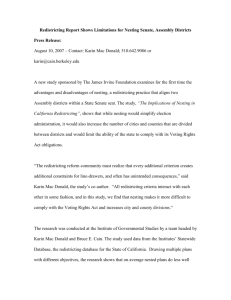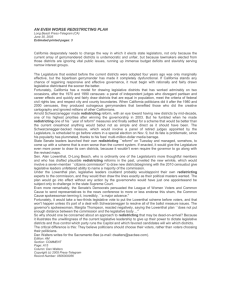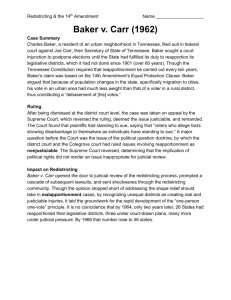Lesson Plan: Reapportionment and Gerrymandering 1. Questions
advertisement
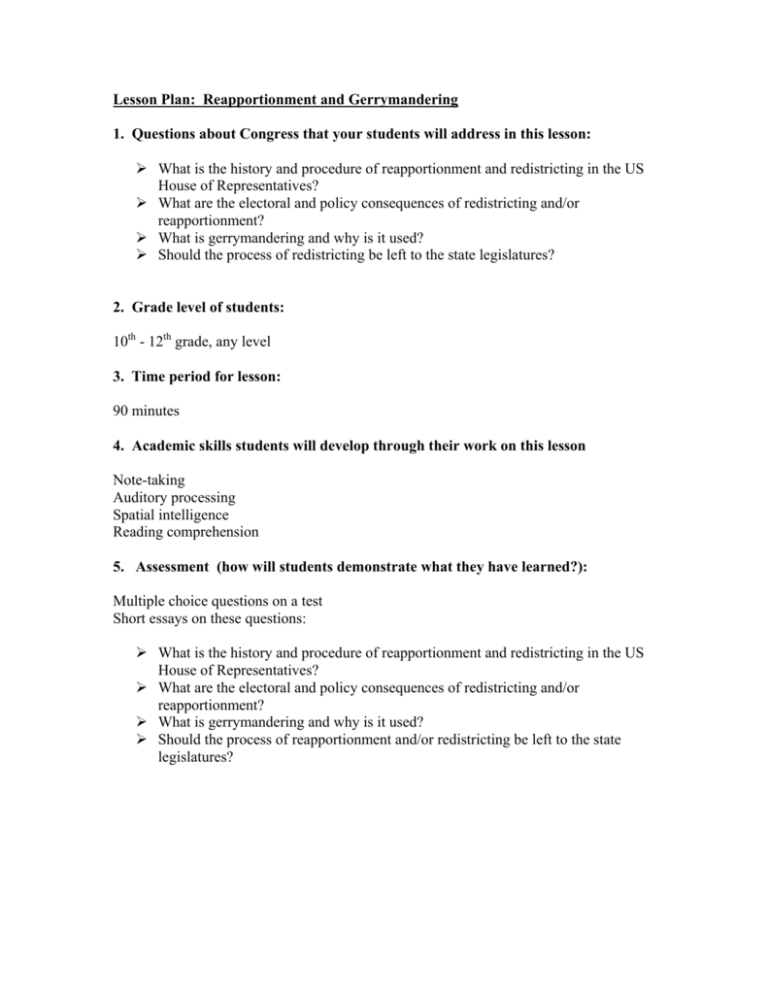
Lesson Plan: Reapportionment and Gerrymandering 1. Questions about Congress that your students will address in this lesson: ¾ What is the history and procedure of reapportionment and redistricting in the US House of Representatives? ¾ What are the electoral and policy consequences of redistricting and/or reapportionment? ¾ What is gerrymandering and why is it used? ¾ Should the process of redistricting be left to the state legislatures? 2. Grade level of students: 10th - 12th grade, any level 3. Time period for lesson: 90 minutes 4. Academic skills students will develop through their work on this lesson Note-taking Auditory processing Spatial intelligence Reading comprehension 5. Assessment (how will students demonstrate what they have learned?): Multiple choice questions on a test Short essays on these questions: ¾ What is the history and procedure of reapportionment and redistricting in the US House of Representatives? ¾ What are the electoral and policy consequences of redistricting and/or reapportionment? ¾ What is gerrymandering and why is it used? ¾ Should the process of reapportionment and/or redistricting be left to the state legislatures? 6. Student activities (describe step-by-step students will do, plus time estimate for each): Part One: Historical overview of reapportionment The teacher will lead a lecture and class discussion following the points listed below, emphasizing that the process of reapportionment and redistricting involves the Census Bureau, Congress and ultimately the state legislatures. ¾ ¾ ¾ ¾ ¾ ¾ ¾ ¾ ¾ ¾ ¾ The Constitution, Article I, Section 2, Clause 3 1842 law on single member districts Reapportionment Act of 1929 The two US maps showing power shift in the US House from 1963 to now Wesberry v. Sanders (1964 ) Reynolds v. Sims (1964) Voting Rights Act of 1965’s preclearance clause Gerrymandering to create safe districts Shaw v. Reno (1993) The Constitution, 14th Amendment’s equal protection clause LULAC v. Perry (2006) (Texas 2003 Redistricting Case) Part Two: The Politics of Reapportionment and Redistricting: Controversy and Consequences Activity One –The student will reapportion a fictional state 1) The teacher draws a box on the board and divides it into four equal parts, numbered one through four then explains the box represents a state with four congressional districts. 2) Appoint four students to be the House members who represent each district. 3) The students come to the board and put a dot inside their district that indicates where they live. 4) The teacher then announces that the state has lost population and therefore has lost a House district. The teacher draws a new box with only three districts in it. It can be done several ways; for example, drawing a peace symbol inside the box creates three districts. 5) Now ask the four students, who has a problem with this new district map? (At least one, maybe two, will now share a district.) 6) Discuss the electoral impact it could have. Activity Two – The students will redistrict and gerrymander a fictional state 1) The teacher draws the box shown on Student Handout One on the board. 2) Distribute Student Handout One to the class. 3) Explain to the students that each letter represents a county in the state as well as the party that has the most support in that county. “R” – Republican Party; “D” – Democratic Party 4) Show the students that in the state, the Republican Party actually has a majority in only two more counties than the Democratic Party. ( 13 Republican counties; 11 Democratic counties) 5) Tell the students that the state has five congressional districts. 6) Tell the students you are going to gerrymander the House districts to give the Republican Party a 4 – 1 advantage, even though the party only has 13 safe Republican counties. (See Teacher Resource, Redistricting Plan One, for the model) 7) As you draw the five districts, ask the students to replicate your lines on Student Handout One. This will be called Redistricting Plan One. NOTE: Remind the students of the rules of redistricting: one-person, one-vote so each district must have at least 4 counties and not more than 5; also must be contiguous, single member districts; and state legislatures in most states draw the lines. 8) Now tell the students to redraw the lines to get the Democrats a better deal. They will use the map on Student Handout Two. Distribute Student Handout Two to the class. NOTE: The Teacher Resource attachment also has an example of how the five districts could be gerrymandered for the Democrats. STUDENT HANDOUT ONE Activity Two: Who’s in charge determines who gets elected The Art and Science of Redistricting Overview ¾ The box with the letters represents a fictitious state, its counties, and the partisan strength in each. ¾ If there is an “R” in the box, the county has more Republican voters; a “D” means more Democratic voters. ¾ There are 24 counties: 13 Republican counties and 11 Democratic counties ¾ Each county has approximately the same population. ¾ The state has five congressional districts. ¾ The districts drawn in Redistricting Plan One have been gerrymandered to give the Republican candidates an electoral advantage. Instructions to students: ¾ Create five congressional districts for the state and gerrymander the lines to give the Democrats a better deal. ¾ One- person, one-vote dictates there must be at least four but no more than five counties in each congressional district. ¾ Remember a district’s geographical span must be contiguous. ¾ A split district is acceptable because it gives the Democrats a 50/50 electoral success rate. Redistricting Plan One R R R D D R D D R R D D R R R R D D D D R R R D STUDENT HANDOUT TWO Redistricting Plan Two: Your Turn R R R D D R D D R R D D R R R R D D D D R R R D Any other ideas? R R R D D R D D R R D D R R R R D D D D R R R D Teacher Resource Redistricting Plan One: an example of gerrymandering for the Republican Party R R R D D R 1 2 D D R R D R R R R D D D R R R D 3 4 D D 5 Redistricting Plan Two: an example of gerrymandering districts for the Democrats R R R D D R 2 3 D D R R D D R R R D D 1 R 5 D D R 4 R R D 7. Resources students will use in their work: a) Teacher will provide notes and/or handouts on the following ¾ ¾ ¾ ¾ ¾ ¾ ¾ ¾ ¾ ¾ ¾ The Constitution, Article I, Section 2, Clause 3 1842 law on single member districts Reapportionment Act of 1929 The two US maps showing power shift in the US House from 1963 to now Wesberry v. Sanders (1964 ) Reynolds v. Sims (1964) Voting Rights Act of 1965’s preclearance clause Gerrymandering to create safe districts Shaw v. Reno (1993) The Constitution, 14th Amendment’s equal protection clause LULAC v. Perry (2006) (Texas 2003 Redistricting Case) b) Student Handout One and Two 8. Lesson extensions: Remind students to follow closely the reapportionment/redistricting process after the 2010 Census. 9. Relevant standards: USG- Explain ways in which Americans can monitor and participate in 5.3 politics and government, including engaging in political leadership or public service, analyzing and becoming informed about public issues and policy making, joining political parties and interest groups, voting, and volunteering in the community. (P)
